Semiconductors are essential for modern day life as we know it. From their usage in integrated circuits for computers’ logic functions to satellite communications, semiconductors allow for efficient and reliable data systems. This becomes particularly essential for the aerospace industry where confidential information in defense systems is constantly at risk. Because of their unique electronic structure semiconductor materials are also well suited for photovoltaic technology, occupying an important role in energy and green power industries. In a world where natural resources are consumed and depleted at an accelerated rate, energy efficient products are gaining in popularity. In today’s article we will explore semiconductor usage in satellite systems, solar cells and laser communications systems.
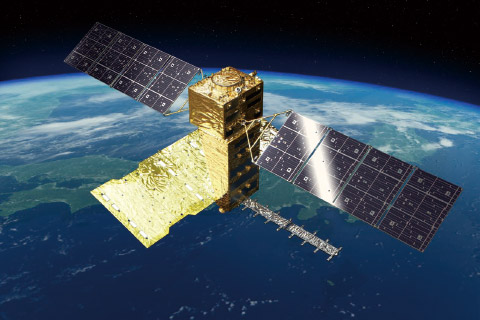
An “Advanced Land Observing Satellite-4 (ALOS-4)” in space. Courtesy of JAXA
Semiconductors in Solar Cells and Panels
Some semiconductors exhibit the photoelectric effect. In brief, this is when incident light on materials frees up electrons that can be used to generate current and power. This idea is utilized in photovoltaic technology, like solar cells. Some of that technology includes solar panels used in calculators, outdoor lighting, and storage batteries like power cells for satellites or other spacecraft.
A typical solar cell is built with a thin semiconductor wafer (sheet). These semiconductors exhibit strong photoelectric properties so that the incident radiation frees up a lot of conducting electrons. In order to form a current with these electrons, we need to create a bias path for them. We can do this through doping (adding impurities) to one side of the semiconductor wafer. As a result, the two sides of the semiconductor will become n-type and p-type. N-type means there is more negatively charged electrons, and p-type means there are holes, and a lack of electrons (positively charged). These two sides will set up an electric field so that once light hits the semiconductor, the free electrons will move along it. Now we have a current flowing, which we can use to generate electric current to power anything we want, even a satellite or a spaceship.
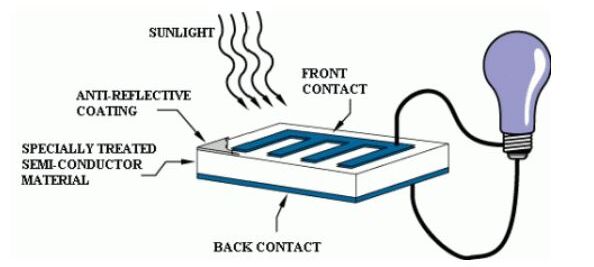
Diagram of a solar/ photovoltaic cell and its components.
Courtesy of NASA
We can produce even more power through electrically connecting many solar cells. This helps collect more light with greater surface area. One set of connected solar cells inside a support frame is called a photovoltaic module. We can connect several modules together to create an even bigger surface area, in a structure called an array. Any level of power can be produced just by different electrical arrangement of the arrays. For each module the light level is proportionate to the power level.
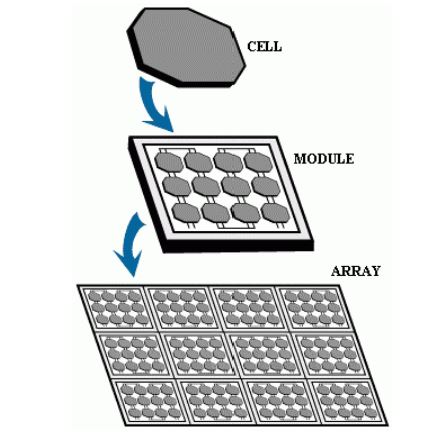
Diagram of solar cell, module, and array in order of complexity.
Courtesy of NASA
Multijunction Solar Cells: Improved Conversion Efficiency
Different semiconductors have different band gap energies. Consequently, not all of the photons (with different energies) incident on one specific solar cell will be absorbed. In order to solve this issue, we can create what are called “multijunction” cells (a.k.a. “cascade” or “tandem” cells). To illustrate, several different semiconductor solar cells are stacked together. First, a high band gap energy semiconductor will be placed at the top and lower band gap semiconductors will be layered below it. The top layer will collect high energy photons. Next, the lower energy photons will trickle down and will be absorbed by the lower band gap energy semiconductors. Therefore, this allows more efficiency in converting solar power to electricity and voltage.
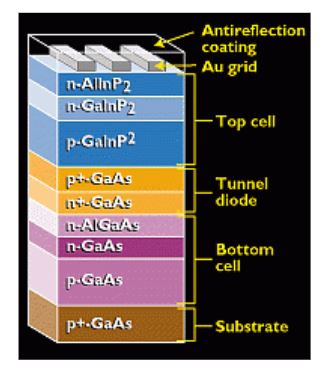
Diagram of a multijunction solar cell. Top layers have higher band gap energy than lower layers.
Courtesy of NASA
Semiconductors in Laser Communication Systems
Laser communications systems are preferred over traditional radio signals in many cases for satellite communications. This is because in lasers, signals are more concentrated (higher frequency) which allows higher data transfer rates, and narrower, precisely directed beams to travel further with less distortion. Additionally, the optical wavelength spectrum doesn’t require licensing and is underused compared to the radio spectrum.
We will now discuss the most important components of this system in detail. Laser communication systems consist of a transmitter, receiver, and a signal propagation channel. The satellites that use laser communication systems have what is called a laser terminal. This terminal consists of the transmitter and receiver, with both systems containing an optical antenna. Antennas help focus and point signals to where they need to go. In optical communication, the most commonly used type of antenna is that which uses a combination of lenses and mirrors (catadioptrics), in telescope fashion.
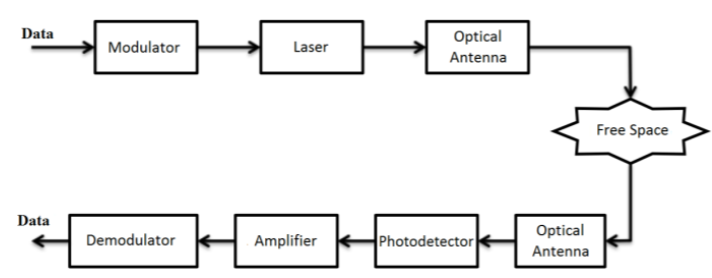
Layout of a laser communication system.
Courtesy of Guimaraes
Transmitter
The main components of a typical transmitter are an antenna, modulator, and laser. The laser’s job is to take an electrical signal and convert it to an optical signal that contains the information the operator wants to relay. This can be done through modulators or diodes. For modulators in laser communications, the best mode is direct intensity modulation. In short, the laser’s driving current is directly manipulated in accordance to what modulation is needed. External modulators may be needed if the laser is in continuous or pulsed operating mode, or if gas lasers that have higher modulation rates, are used. In addition, to create the highest antenna gain, the laser should be set to a single transverse operating mode.
Laser type is chosen based on the particular mission. Some things to consider are distance or altitude, power required, and level of radiation around the equipment and signals. Semiconductor Lasers are some of the most preferred solid-state laser types used in satellite communications systems. For example, Gallium Arsenide and Aluminum Gallium Arsenide lasers are small and easy to combine into arrays, easily modulated, and are hardy. Its wavelengths are in the 0.78- 0.9 µm range and its lifetime is around 20,000 hours. Other gas lasers have over double the lifetime of semiconductor lasers, but they are much more difficult to modulate and require complex, extra instrumentation.
Receiver
Next, the receiver contains an antenna, filter, photodetector, and an electronic receiver. The receiver does the opposite job of the transmitter and converts an optical signal into an electrical signal. Similar to solar cells discussed in the last section, the receiver uses the photoelectric effect to do this job. To take advantage of this effect, the most commonly used device in laser communications is the photodiode. In short, this is because they are small, inexpensive, and pick up signals very easily. Among the types of photodiodes, the best ones for laser communications is the pin photodiode and the avalanche photodiode. Similar to the transmitters, these devices also use semiconductors to operate.
Looking Forward
As we have seen in this article and our daily lives, semiconductors are key to the history and technological advancements of the 20th and 21st century. From their usages in communications and energy, they can truly revolutionize those industries for our ever changing needs in an even more rapidly changing world. The future of semiconductor technology will keep expanding as new research is being done in academic and industrial labs to help find new and better materials, functions, and avenues for semiconductor tech.
This article is sponsored by Gentec-EO - provider of tools for laser beam diagnostics
